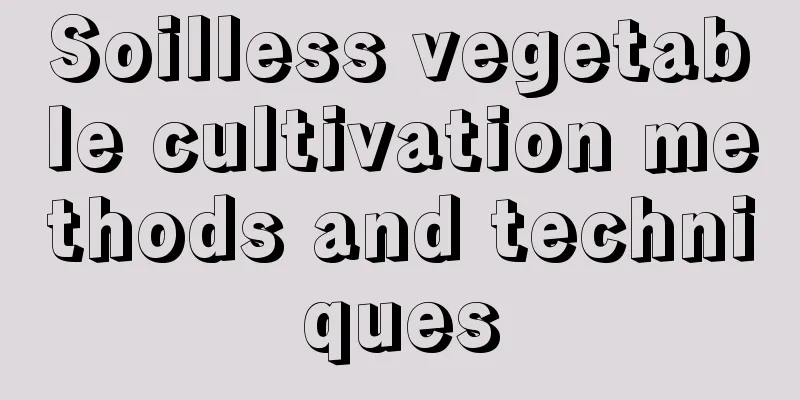Soilless vegetable cultivation methods and techniques

|
With the continuous development of agricultural technology, soilless cultivation technology has become an important part of modern agricultural production. The advantages of this technology are high yield, good quality, easy management, etc. At the same time, it can also avoid problems such as soil pollution and continuous cropping obstacles. So what are the methods and techniques for growing vegetables without soil? Let’s learn more about it below. 1. Planting method 1. Hydroponics It is to cultivate crops by soaking their roots directly in water. But it should be noted that the water here is not the pure water we see in daily life, but a nutrient solution. Using nutrient solution instead of soil can provide crops with the nutrients and water they need to grow. 2. Substrate culture Substrate cultivation refers to the use of solid mechanisms to fix the root system, through watering nutrient solution or using solid fertilizer, so that crops can absorb more nutrients and oxygen and other nutrients. It is a more commonly used soilless cultivation technology. 3. Open rock wool culture Open rockwool cultivation means planting vegetables in rockwool, and then dripping nutrient solution into the rockwool planting mat through drip irrigation, so that sufficient nutrients can be absorbed. If there are excess nutrients, they can also flow out from the bottom of the planting mat and be discharged outdoors. This method is both convenient and scientific. 2. Technical points 1. Matrix selection When selecting vegetable substrates, you need to choose materials with excellent air permeability, low cost, high performance and strong water retention. The more common matrices are slag and gravel. 2. Preparation before sowing First, you need to select the vegetables to be cultivated, choose high-quality varieties, soak them, and then start germination to facilitate the germination and emergence of the seeds. In addition, the large-scale use of soilless cultivation generally requires a large investment and the preparation of a variety of facilities, usually requiring the installation of nutrient solution tanks, cultivation beds and nutrient solution systems. 3. Cultivation methods In the process of soilless cultivation of vegetables, you need to prepare planting bags first. Generally, white polyethylene plastic bags with a thickness of 0.1 mm and a width of 7 cm are selected. After the plastic bags are folded into double layers, ropes are put on both sides to make the bags appear as "U"-shaped bags with a cross-section of 20 cm. 4. Nutrient solution management Group the macro-, medium- and trace-element fertilizers and nutrient solution fertilizers and add them directly to the substrate, that is, separate the fertilizers that can form chemical precipitation. First add one group of fertilizers into the fertilizer tank. During the drip irrigation process, dissolve the fertilizers and drip them into the substrate. When they are fully dissolved, stop the drip irrigation and add another group of fertilizers until the drip irrigation is finished. How to choose the cultivation medium ? Soilless culture substrate method - Image copyright belongs to All"> The above is a brief sharing of methods and techniques for soilless vegetable cultivation. In short, although it is a new technology, it is not a very complicated high-tech and is relatively simple and easy to learn. In addition to preparing the planting bags before planting, the substrate is also a very important material, and subsequent related management work such as nutrient solution will be done.
|
<<: Potted grapes bear fruit for several years, but what should I do if they don’t?
Recommend
How to cultivate the striated sycamore and how to prune it to make it bloom
1. Cultivation method of striated bell flower 1. ...
Where do cocoa fruits grow? Where do cocoa trees grow?
The fruit of the cocoa tree is called cocoa pod ,...
How does the copper green unicorn bloom?
1. Good lighting The copper green unicorn loves s...
How to save cauliflower seeds and how do seeds grow?
How to save cauliflower seeds Cauliflower is also...
How to pollinate orchids and how to make orchid seeds germinate
1. How to pollinate Orchids rely on insects for p...
Black Master potting precautions
Black Master potting precautions On average, the ...
Green onion cultivation time
Green onions , as a common ingredient on the Chin...
Green coral cultivation methods and precautions
Green coral is also called the bachelor tree. It ...
How long is the growth period of white melon?
Introduction to the growth of white melon White m...
Can chrysanthemum be cultivated hydroponically? How to cultivate hydroponically chrysanthemum
Can chrysanthemum be grown hydroponically? Chrysa...
When is the sponge gourd ripe? Can it be grown at home?
1. What season is the dish? Luffa is a common veg...
What disease does Charizard have?
1. Soft rot Symptoms: The plant is still upright,...
How to spend the summer with Xiao Mi Xing
illumination Since millet star has entered a dorm...
The difference between sea daffodils and hydrangeas
Introduction to Sea Daffodil and Weigela The sea ...
How to grow Jade Plant in winter?
Jade plant is a plant with unique ornamental valu...









